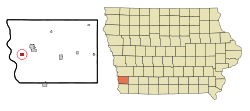
Des Moines County is located in the U.S. state of Iowa. As of the 2020 census, the population was 38,910. The county seat and largest city is Burlington. It is one of Iowa's two original counties along with Dubuque County; both were organized by the Michigan Territorial legislature in 1834.

Sheldahl is a city in Polk, Boone, and Story counties in the U.S. state of Iowa. The population was 297 at the time of the 2020 census.

Clive is a city in Dallas and Polk counties in the U.S. state of Iowa. As of the 2020 Census, the population was 18,601. It is part of the Des Moines–West Des Moines Metropolitan Statistical Area. Clive is known for its Greenbelt Park and trail system running through the community. Clive serves as the axis of the western Des Moines suburbs, between Urbandale, Waukee and West Des Moines along the major transportation corridors of I-35, I-80 and I-235. The City of Urbandale is to the north to northwest, the City of West Des Moines is to the southeast to southwest, the City of Waukee in Dallas County is to the west.

De Soto is a city in Dallas County, Iowa, United States. The population was 915 at the time of the 2020 census. It is part of the Des Moines–West Des Moines Metropolitan Statistical Area.

West Des Moines is a city in Polk, Dallas, Warren, and Madison counties in the U.S. state of Iowa. A majority of the city is located in Polk County, a minority of the city is located in Dallas County, and small portions extend into Warren and Madison counties.
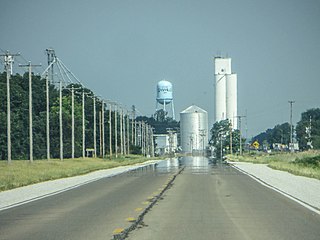
Danville is a city in Des Moines County, Iowa, United States. The population was 927 at the time of the 2020 census. It is part of the Burlington, IA–IL Micropolitan Statistical Area.
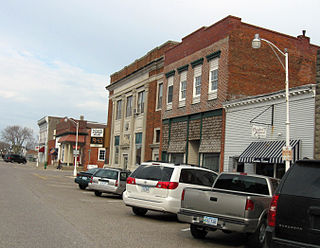
Mediapolis is a city in Des Moines County, Iowa, United States. Its population was 1,688 at the time of the 2020 census. It is part of the Burlington, IA–IL Micropolitan Statistical Area.
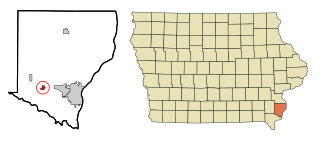
Middletown is a city in Des Moines County, Iowa, United States. The population was 363 at the time of the 2020 census. It is part of the Burlington, IA–IL Micropolitan Statistical Area.

West Burlington is a city in Des Moines County, Iowa, United States, adjacent to the Mississippi River city of Burlington. The population was 2,968 at the 2010 census. It is part of the Burlington, IA–IL Micropolitan Statistical Area.

Hamburg is a city in Fremont County, Iowa, United States, that is the most southwestern city in Iowa, hugging the borders of Missouri to the south and Nebraska to the west. It is situated between the Nishnabotna and Missouri rivers. The population was 890 at the time of the 2020 census. It derives its name from the German city of Hamburg.

Winfield is a city in Henry County, Iowa, United States. The population was 1,033 at the time of the 2020 census.

Thornburg is a village in Keokuk County, Iowa, United States. The population was 45 at the time of the 2020 census. Its sole enterprise is the Tri-County Community School, a public school serving grades K-12.

Columbus Junction is a city in Louisa County, Iowa. The population was 1,830 at the 2020 census. It is part of the Muscatine Micropolitan Statistical Area.

Ackworth is a city in Warren County, Iowa, United States. The population was 115 at the 2020 census.
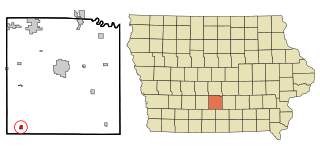
New Virginia is a city in Warren County, Iowa, United States. The population was 498 at the time of the 2020 census. It is part of the Des Moines–West Des Moines Metropolitan Statistical Area.

Norwalk is a city in Warren County, with some small portions extending into Polk County, in the U.S. state of Iowa. The population was 12,799 at the time of the 2020 census. The city is part of the Des Moines metropolitan area and is located just south of the Des Moines International Airport.

Brighton is a city in Washington County, Iowa, United States. It's part of the Iowa City, Iowa Metropolitan Statistical Area. The population was 600 at the 2020 census.

Callender is a city in Webster County, Iowa, United States. The population was 368 at the time of the 2020 census.

Corning is a village in Holt County, Missouri, United States. The population was 3 at the 2020 census.
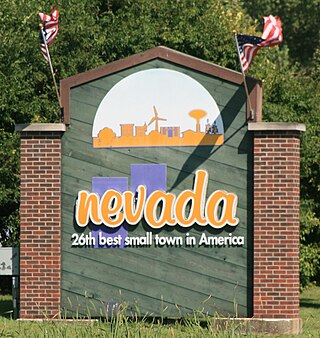
Nevada is a city in, and the county seat of, Story County, Iowa, United States. The population was 6,925 in the 2020 census, an increase from 6,658 in 2000. Nevada is part of the Ames, Iowa Metropolitan Statistical Area, which is a part of the larger Ames-Boone, Iowa Combined Statistical Area. Nevada is the second-most populous city in Story County. The city's name is pronounced differently from the U.S. state of Nevada.

